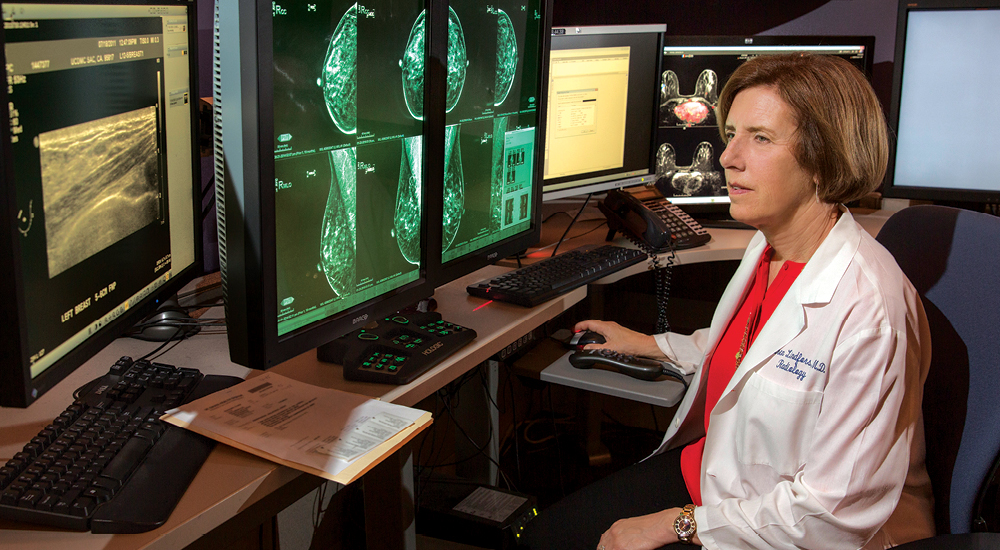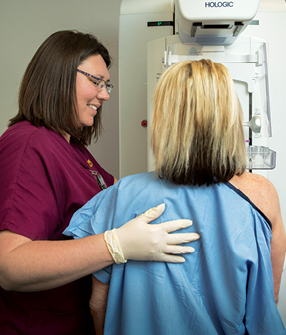
To screen or not to screen?
Patient, professional perspectives on guidelines vary
Until recently, Karen Lindfors wrapped up most appointments with a common message to patients: “See you next year.”
As chief of breast imaging at the UC Davis Comprehensive Cancer Center, Lindfors knew that for the majority of women in her care, an annual mammogram made good medical sense.
But new guidelines have changed the mammography landscape, and advising women on how best to detect breast cancer is more complicated today.
“It was a lot easier when we could say, ‘ok, everybody begin screening at age 40 and get screened annually forever,’” recalls Lindfors, who is also a professor of radiology at the UC Davis School of Medicine. “But there is no one-size-fits-all answer anymore, so it’s a more individualized decision. That can be challenging, and I think it’s easy to see why some women are confused.”
The confusion stems in part from updated mammogram screening guidelines produced by two organizations at the front lines of America’s fight against cancer — and influenced by ongoing research at UC Davis.
In October 2015, the American Cancer Society changed its position to recommend that women get annual screenings beginning at age 45, rather than 40, and then wait two years between mammograms starting at age 55. The organization also said women should be able to start getting mammograms at 40 if they so choose.
Soon after, the U.S. Preventive Services Task Force, a national panel of experts that makes recommendations on clinical preventive services, updated its guidelines, advising women to get screened every other year beginning at 50. Women under 50, the task force said, should make a personal choice about biennial screening based on their own preferences and in consultation with their doctor.
The guidelines are designed for women who are in good health and do not have a strong family history of breast cancer or other factors that put them at high risk. Both sets of guidelines reflect the medical community’s move toward a less aggressive screening strategy that seeks to better balance the proven benefits of mammography with its downsides. The changes also reemphasize that while mammography remains an essential diagnostic tool, it’s not perfect.
Nearly 232,000 American women were diagnosed with breast cancer in 2015 and an estimated 40,000 were expected to die of it, according to the National Cancer Institute (NCI). About one in eight women will be diagnosed with the disease at some point in their lives, the NCI says.
Widespread mammographic screening began in the United States in the 1980s after multiple studies found it prevents breast cancer deaths by detecting breast tumors early, when they are smaller and more treatable. While its benefits remain indisputable — a mortality reduction of at least 25 percent for women aged 50 to 69 — the evidence for women 40 to 49 is less clear, and newer data highlight potential harms triggered by mammography in women of all ages, including anxiety surrounding false positive tests and unnecessary biopsies.
Over-diagnosis, too, has sparked concern because some early tumors found by mammograms, ductal carcinoma in situ (DCIS), may never progress to life-threatening invasive cancer. Indeed, because some DCIS tumors are low-risk, some scientists have proposed renaming DCIS to exclude the word “carcinoma.”
What’s tricky is that on mammography there is no way to differentiate DCIS that is life-threatening and that which is not. As a result, doctors are inclined to treat them all as potentially progressive, an approach that can mean extensive follow-up, which may include biopsy, surgery, radiation and chemotherapy, an approach similar to standard therapy for invasive cancers.
“Mammography detects some cancers that would never have been diagnosed in a woman’s life if she hadn’t been screened, and we treat those the same way as other cancers,” says Diana Miglioretti, a professor of biostatistics at the UC Davis School of Medicine.
Some women see that as a good reason to get mammograms less often.
During a routine physical in 2011, Therese Taylor’s doctor felt a lump in her right breast. That led to a mammogram, which found nothing in the right breast but detected micro-calcifications in the milk ducts of her left breast. A biopsy produced a diagnosis — DCIS.
“That was a Wednesday, and by Friday I had a date for surgery,” the 56-year-old Taylor recalls, noting that the quick scheduling implied her situation was urgent. “What I wasn’t told was that there is considerable controversy over whether DCIS should even be called ‘cancer,’ and that even if it was, it would grow slowly, and I could have safely opted to get treated at a later time.”
Instead, Taylor had a mastectomy. And now she believes a lack of information from her doctors and decades of “brainwashing about how mammograms always save lives” drove her to make the wrong choice.
But others, Lindfors notes, are willing to accept the risk of potentially unnecessary procedures when the benefit may be a life-saving discovery.
“If I can’t definitively tell a patient that her lesion won’t become an invasive cancer, and if I say we could just watch it and see what happens, most women will still want to have it treated,” says Lindfors.
Pam Phelps supervises breast imaging at UC Davis. Nevertheless, in 2010 she skipped her annual mammogram. The following year she was diagnosed with invasive breast cancer, had a mastectomy and chemotherapy. She was 54.
“Some researchers say there is frustration, agony and anxiety about false positives, but I don’t buy it,” says Phelps, who now gets both a mammogram and a breast MRI annually to monitor for recurrence. “I would much rather have a false positive result than skip a year like I did, and then find out I have breast cancer.”
At UC Davis, researchers are developing diagnostic equipment that may lead to more concise imaging. Others work in pathology laboratories and hope to unravel the mystery of which early cancers will progress and which won’t.
“I think we are all converging on the fact that there is some over-diagnosis,” says Joy Melnikow, who directs the UC Davis Center for Healthcare Policy and Research and has participated in multiple breast cancer studies. “But we still need to determine which cancers will become active in order to avoid overtreatment.”
Melnikow was a member of the U.S. Preventive Services Task Force when it first recommended making mammography before age 50 an individual choice, back in 2009. It was a controversial decision that not only sparked warnings from critics who said it would put lives at risk, but also became a hot topic in the nation’s partisan health care debate.
“It was a challenging experience,” Melnikow says. “But we base our recommendations on the best available evidence about the benefits and potential harms of screening. Beyond that it’s up to doctors to help each woman evaluate her history and preferences and make a decision that’s right for her.”
Miglioretti’s breast cancer research spans 16 years and includes serving as co-leader of the Breast Cancer Surveillance Consortium (BCSC). The nation’s largest collection of information on mammography, BCSC consists of six breast imaging registries across the U.S. One of her studies, published in 2015 in the Journal of the American Medical Association Oncology and based on BCSC data, helped shape the latest American Cancer Society mammogram guidelines.
Miglioretti was also first author on a comprehensive modeling study evaluating the risk of radiation-induced breast cancer. That study, published in the Annals of Internal Medicine, was one of several that guided revisions to the task force’s mammography guidelines. Melnikow and Joshua Fenton, a professor of family and community medicine and an expert on cancer screening, also contributed.
Scientists hope that technological advances, both with mammography and other screening modalities, will reduce the incidence of false positives. At UC Davis, medical physicist John Boone has worked on breast cancer imaging research since the 1990s, and has developed CT scanners to improve the accuracy and sensitivity of screening.
Boone and his team, which includes Lindfors, have built four such scanners, each incorporating knowledge gained from the previous model. Equipped with a $2.88 million NCI grant, Boone is working on a project he calls “Breast CT: Final Steps to Translation.” The research involves 400 women with suspicious lesions that require breast biopsy.
The study will compare mammography with breast CT to determine which is better at detecting breast lesions ultimately proven to be cancerous. Boone also will compare contrast-enhanced breast CT with contrast-enhanced MRI. If shown to be equivalent to MRI, breast CT would be a “viable and far more cost-effective tool for imaging women with suspicious lesions,” Boone says, likely reducing the negative biopsy rate and increasing the predictive value of breast imaging in general.
As Boone sees it, technology will play a key role in the debate over how best to help women navigate the choppy waters of breast cancer screening and treatment. He hopes his breast CT will “outperform screening mammography so we can change the paradigm and better serve women.”


